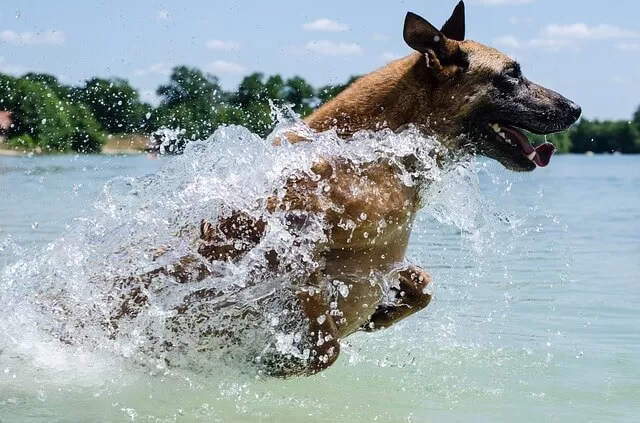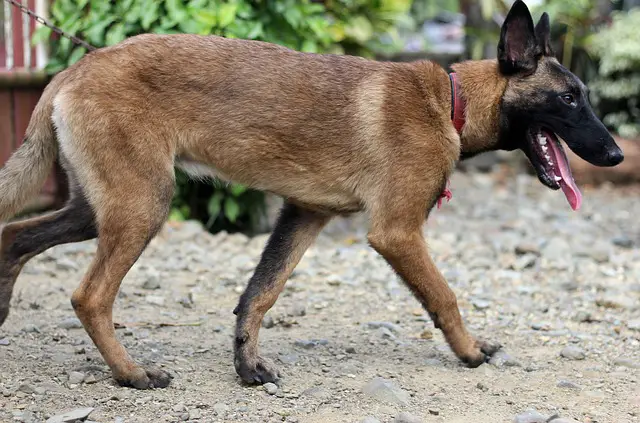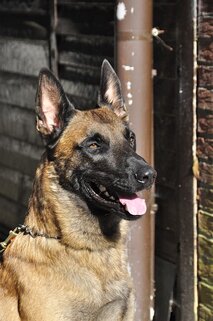The Belgian Malinois is a breed often mistaken for a German shepherd if you aren’t too familiar with either, although they each have a distinct look and appearance. Like the German shepherd, the Belgian
Malinois is a herding dog, bred for sheep herding, and can exhibit a wide range of temperament traits, one being aggressiveness.
That being said, any breed of dog can have aggressive tendencies and this can go back to their heredity and also their upbringing, composed of socialization and training.
In this post, you will find information about Belgian Malinois. Is the Belgian Malinois aggressive? Some can be, but any breed can display aggression.
I will include how to stop Belgian Malinois from aggressive behavior and how to prevent it from even occurring. Read along to find out all about the Belgian Malinois if you are considering owning one.

For your dog’s vitamin supplement, food, toys, or other dogs product please visit the Sundays for dogs website.
Origin and History of the Belgian Malinois
Bred in Malines, a city in a region of northwest Belgium, the Belgian Malinois is often referred to as the Belgian sheepdog along with three other breeds, the Belgian shepherd, Laekenois, and Tervuren. Registered in 1959 in the United States, the Malinois is its own breed separate from the others.
The Belgian Malinois was bred as a very serious dog for herding sheep and cattle. Today, they are still excellent herders, but due to their working ad guarding abilities, has branched out to become stellar K-9s of military and law enforcement officers.
To check your Belgian Malinois health status or their DNA, please visit the Embark vet website for all the help you may need.
Belgian Malinois Appearance
The female Belgian Malinois may weigh from 40lbs to 60lbs, while the male can weigh in between 60lbs and 80lbs.
The female will display a more feminine demeanor and the male may be bulkier and seem sturdier, appearing quite impressive.
As compared to a German shepherd, the Belgian is not as big, with a smaller head, shorter fur, and a coat of rich mahogany to light fawn, sporting black tips, distinctly different from the German shepherd’s usually black and tan.
The German shepherd is stockier and the Belgian has long finer boned legs. The Belgian shepherd also displays a black mask and black triangular ears.

Belgian Malinois Temperament
The Belgian Malinois is a very obedient and intelligent dog. Their instinct is to protect, so this is good to keep in mind if you are considering owning one.
They can be excellent family dogs because they do adore being with their family, however, early socialization, as well as training, is a must.
As herding dogs, they will definitely and instinctively want to herd their family into one area by nipping and biting at one’s heels.
This behavior will have to be curbed with training. They may not be a suitable breed for those with small children or toddlers as too much screaming and dashing about will bring out that herding behavior.
They are loving and loyal to the right home. A Belgian Malinois also wants to be with its family, therefore, they do not make a good outdoor dog kept in a kennel.
Aggression in the Belgian Malinois
Understanding the Belgian Malinois, they are still instinctively herding dogs but they have evolved into a top-of-the-line working dog as well.
The Malinois works efficiently with the military and police as a bomb detector and drug sniffer. They are a protective dog that guards well, and also excel with game officers, protecting wildlife with their excellent sense of smell.
The Belgian will do fine in a family setting, but they need the right kind of owner and training.
This breed can be considered among some others that have a propensity towards aggression, but they have been bred to be protective instinctively. They are loyal to their owner or family and will defend them against harm.
A police department in a town in Germany now uses the Belgian Malinois instead of German shepherds because they found they are more aggressive when necessary and will defend their handlers when in dangerous situations better than German shepherds. Belgian Malinois is also used exclusively by the Navy Seals.
If you are thinking about getting a Belgian shepherd, you should consider carefully if you are up to the task. No breed is born aggressive, but this breed does require time and training.
By all means, you can have an excellent, obedient, and loyal family dog, but it will require some work. As the saying goes, “there are no bad dogs, just bad owners.”
This saying is so true because we are the ones who teach and train our dogs the rules, right from wrong and good from bad and we need to do this with consistency.

Belgian malinois Signs of Aggression
Listed below are a few signs of aggression in dogs.
- The body becomes rigid and stiff
- Cold stare at the object of aggression
- The fur is raised on the back
- Showing or baring teeth
- Snapping
- Growling
- Lunging
Preventing and Dealing With Aggression
To prevent aggression in your Belgian Malinois before it even arises, three main ideas are the way to impede the problem: breeding, socialization, and training. Below are details about each of these main ideas and a few extra tips.
Breeding
When considering getting a Belgian Malinois, seek out only reputable breeders and ones that you have good references for.
Visit the breeder and the kennels and observe the breeding dogs for any signs of aggression. Question the breeder about any problems with the pups he has sold.
If they are a serious breeder and conscientious with their business, they will not be offended by any questions you may have.
Socialization
When you bring your Belgian Malinois puppy home begin to introduce them to different people, places sights, sounds, smells, other dogs, etc. In this way, new situations will not seem daunting or fearful and they will take each new experience in stride.
Dogs do not always become aggressive and bite to defend other people, they sometimes bite out of fear and this is due to a lack of socialization.
The more situations they are exposed to, the better they will handle new introductions. They will not be fearful when meeting new people or when loud noises occur.
Training
Training is essential for any breed, but especially for the Belgian Malinois. If you are unsure of where to begin, ask their breeder or veterinarian, buy a book, see the collection of Belgian malinois training books or DVDs on the subject or take your pup to puppy classes, or online training courses such as Brain Training for Dogs.
Classes are fabulous to help you with and show you the proper way to do things. It also gives the puppy needed socialization with other owners and dogs alike.
You may move on to advanced classes as your Belgian grows, with help and tips as they further develop. Classes are a valuable asset that provides you with help every step of the way.
Keeping up with training at home is a must. You need to be consistent at home so the puppy always knows the rules. You must always assume the role of alpha pack leader.
There should be no confusion on your pup’s part as to who is in charge, allowing no challenge to your leadership. When puppies are small, keep training sessions short and give plenty of positive reinforcement.
Exercise and play
Belgian Malinois are extremely energetic. Exercise is a must to keep them healthy, and fit to expend that drive and hustle, and also to keep them from getting bored which can lead to destructive behavior. This is the case with any breed with boundless energy.
Just as in humans, when we exercise we release endorphins, chemicals that give us a happy feeling and the same goes for dogs. They get that same high from the “feel good” hormones.
Play with retrieving games, balls and frisbees keeps your pup active but also gives their brain a workout too.
Spay or Neuter
If you do not intend to breed your Belgian Malinois, then spaying or neutering is the way to go. This will prevent health problems down the road and can, in some instances, prevent dominant and aggressive tendencies. It can also eliminate other behavioral problems as well.
Stopping Nipping and Biting
In Belgian puppies, their herding instinct may cause nipping and biting, which is unacceptable behavior and will be more so in an adult.
If your pup constantly nips at everyone’s heels as they walk, trying to herd them, simply stop in your tracks and ignore them. Don’t play with them and give them a sort of “time out” for five or ten minutes. Then you may resume playing or walking.
If you are diligent with this, they will soon realize that with this type of behavior, play stops and they get no attention, good or bad.
All of these tips should help to prevent or stop aggressive behavior in your Belgian. When they are older, if you see aggressive tendencies crop up, don’t wait to address them, especially if you have people or children visiting your house on a regular basis.
See what is triggering this behavior and speak with your veterinarian or seek out a trainer or behavioral specialist for professional help such as Brian Training for dogs.
If you are considering adding a Belgian Malinois to your family, do your research and know that they are intelligent and highly trainable, but need consistency, patience, and positive reinforcement.
With the right training, the Belgian Malinois can be a stellar, loyal, and well-mannered family member for years to come.